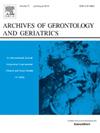某老年康复住院单位谵妄患病率:患者临床特征及危险诱发因素分析
IF 3.5
3区 医学
Q2 GERIATRICS & GERONTOLOGY
引用次数: 0
摘要
目的是评估从急症护理医院出院并入住老年康复病房(GCU)的患者谵妄的患病率,并分析患者的特征和危险诱发因素。68例患者在2周的时间内进行了分析。神志不清评定法(CAM)检测谵妄。评估的诱发因素包括:大手术-重症监护病房(ICU)住院、肺和心力衰竭、急性感染、代谢紊乱/贫血、精神活性药物、其他药物、剧烈疼痛、不断变化的环境影响等。根据CAM, 15例患者出现谵妄(22%),其中14例(93.3%)在GCU入院前出现谵妄。研究人群的诱发因素如下:66例(97%)患者的环境影响变化(谵妄15例,非谵妄51例);其他56种(82.3%)(11比45);其他56种(82.3%)(9比24);精神药物50例(73.5%)(12对38);急性感染48例(70.5%)(13例对35例);代谢性疾病/贫血40例(58.8%)(9对31);大手术- icu住院28例(41.1%)(8例对20例);重度疼痛26例(38.2%)(6对20);肺和心力衰竭22例(32.3%)(5 vs. 17)。单变量分析显示,所有诱发因素均与谵妄无显著相关性。72例(91.1%)患者同时存在3个以上的诱发因素。诱发因素>6者16例,伴谵妄者15例中7例,无谵妄者53例中9例(46.6% vs 16.9%),差异有统计学意义(p < 0.05)。谵妄的患病率为22%。多数患者入院前已出现谵妄。较高比例的患者有>3个诱发因素。在本研究中,大于6种沉淀因素同时存在与谵妄有显著关系。本文章由计算机程序翻译,如有差异,请以英文原文为准。
PREVALENCE OF DELIRIUM IN A GERIATRIC CONVALESCENCE HOSPITALIZATION UNIT: PATIENT’S CLINICAL CHARACTERISTICS AND RISK PRECIPITATING FACTOR ANALYSIS
求助全文
通过发布文献求助,成功后即可免费获取论文全文。
去求助
来源期刊
CiteScore
7.30
自引率
5.00%
发文量
198
审稿时长
16 days
期刊介绍:
Archives of Gerontology and Geriatrics provides a medium for the publication of papers from the fields of experimental gerontology and clinical and social geriatrics. The principal aim of the journal is to facilitate the exchange of information between specialists in these three fields of gerontological research. Experimental papers dealing with the basic mechanisms of aging at molecular, cellular, tissue or organ levels will be published.
Clinical papers will be accepted if they provide sufficiently new information or are of fundamental importance for the knowledge of human aging. Purely descriptive clinical papers will be accepted only if the results permit further interpretation. Papers dealing with anti-aging pharmacological preparations in humans are welcome. Papers on the social aspects of geriatrics will be accepted if they are of general interest regarding the epidemiology of aging and the efficiency and working methods of the social organizations for the health care of the elderly.

 求助内容:
求助内容: 应助结果提醒方式:
应助结果提醒方式:


